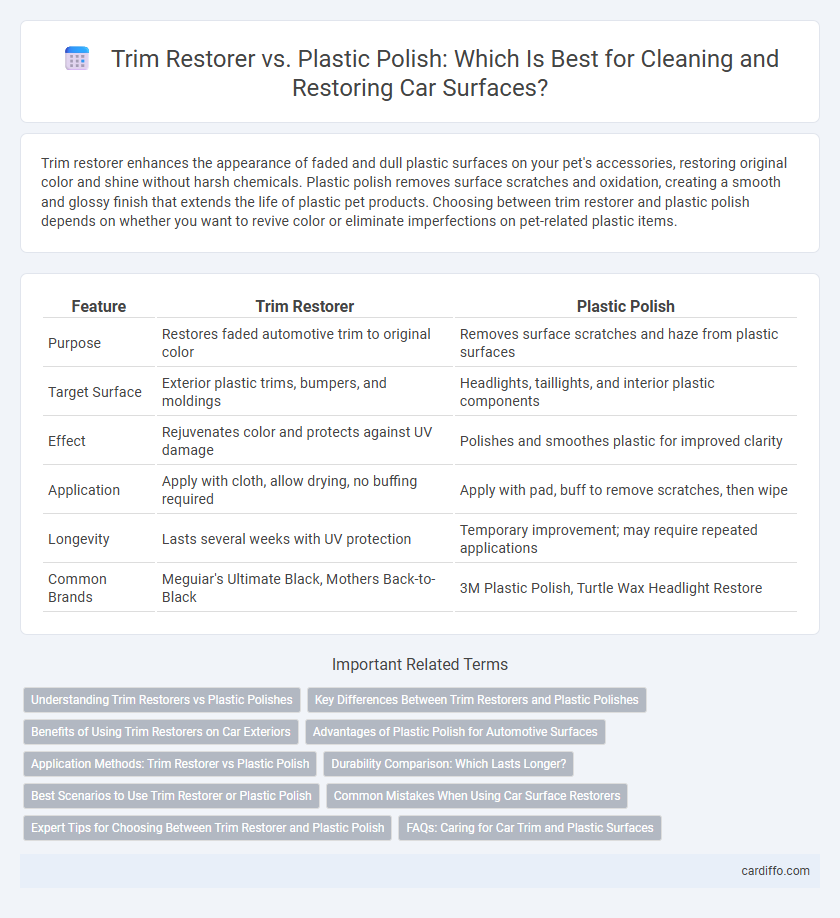Trim restorer enhances the appearance of faded and dull plastic surfaces on your pet's accessories, restoring original color and shine without harsh chemicals. Plastic polish removes surface scratches and oxidation, creating a smooth and glossy finish that extends the life of plastic pet products. Choosing between trim restorer and plastic polish depends on whether you want to revive color or eliminate imperfections on pet-related plastic items.
Table of Comparison
| Feature | Trim Restorer | Plastic Polish |
|---|---|---|
| Purpose | Restores faded automotive trim to original color | Removes surface scratches and haze from plastic surfaces |
| Target Surface | Exterior plastic trims, bumpers, and moldings | Headlights, taillights, and interior plastic components |
| Effect | Rejuvenates color and protects against UV damage | Polishes and smoothes plastic for improved clarity |
| Application | Apply with cloth, allow drying, no buffing required | Apply with pad, buff to remove scratches, then wipe |
| Longevity | Lasts several weeks with UV protection | Temporary improvement; may require repeated applications |
| Common Brands | Meguiar's Ultimate Black, Mothers Back-to-Black | 3M Plastic Polish, Turtle Wax Headlight Restore |
Understanding Trim Restorers vs Plastic Polishes
Trim restorers rejuvenate faded automotive exterior trims by penetrating and restoring UV-damaged plastic, preventing further discoloration and cracking. Plastic polishes primarily remove surface scratches and oxidation from clear plastic lenses, improving clarity and shine without significantly altering the material's color. Selecting between trim restorers and plastic polishes depends on the restoration goal--color revitalization versus scratch removal--and the specific type of plastic surface being treated.
Key Differences Between Trim Restorers and Plastic Polishes
Trim restorers are specifically designed to rejuvenate faded automotive plastic trim by restoring its original color and providing UV protection. Plastic polishes focus on removing surface scratches, oxidation, and minor imperfections to enhance the clarity and smoothness of plastic surfaces. While trim restorers primarily address color restoration and protection, plastic polishes improve surface texture and visual clarity.
Benefits of Using Trim Restorers on Car Exteriors
Trim restorers effectively revive faded and oxidized plastic and rubber surfaces on car exteriors, restoring a like-new appearance by replenishing lost oils and pigments. They provide long-lasting protection against UV damage, preventing future fading and cracking while enhancing the overall aesthetic appeal of the vehicle. Compared to plastic polish, trim restorers are specifically formulated to penetrate and nourish exterior trim, ensuring improved durability and resistance to environmental elements.
Advantages of Plastic Polish for Automotive Surfaces
Plastic polish offers superior restoration for automotive surfaces by effectively removing fine scratches and oxidation, enhancing clarity and shine without damaging trims. It contains micro-abrasives and fillers that smooth out imperfections, providing a long-lasting protective layer against UV rays and environmental contaminants. Compared to trim restorer, plastic polish delivers a cleaner, more durable finish that maintains the vehicle's aesthetic appeal over time.
Application Methods: Trim Restorer vs Plastic Polish
Trim restorer typically requires application with a microfiber cloth or foam applicator pad, ensuring even coverage and quick absorption into exterior plastic trims. Plastic polish is applied using a soft cloth or dual-action polisher, designed to abrade and smooth plastic surfaces, often necessitating multiple passes for optimal clarity. Proper technique and pressure are crucial for both products to achieve the desired restoration without damaging the material.
Durability Comparison: Which Lasts Longer?
Trim restorer products typically offer longer-lasting durability by penetrating and rejuvenating the plastic surface, providing protection against UV damage and fading for several months. Plastic polish mainly cleans and smooths the surface, offering a short-term shine but lacking the protective properties to prevent rapid deterioration. Choosing a trim restorer ensures extended preservation of exterior plastic trim compared to the temporary enhancement achieved by plastic polish.
Best Scenarios to Use Trim Restorer or Plastic Polish
Trim restorers work best on faded, UV-damaged car exterior trim by replenishing color and providing a protective layer that prevents further degradation. Plastic polishes are ideal for removing surface scratches, haze, and oxidation from clear or painted plastic parts, restoring clarity and shine without adding color. Choosing trim restorer for matte or textured plastic enhances appearance, while plastic polish suits transparent plastics like headlights or instrument covers for optical clarity.
Common Mistakes When Using Car Surface Restorers
Common mistakes when using trim restorers and plastic polishes include applying product on dirty or oily surfaces, which reduces effectiveness and leads to uneven results. Overuse of trim restorer can cause buildup and attract dirt, while excessive rubbing with plastic polish may scratch or dull the surface. Proper surface preparation and following manufacturer guidelines are essential to maximize the benefits of car surface restorers and avoid damage.
Expert Tips for Choosing Between Trim Restorer and Plastic Polish
Expert tips for choosing between trim restorer and plastic polish emphasize the material condition and desired finish; trim restorers rejuvenate faded, weathered plastic trims by replenishing UV protection and color, while plastic polishes focus on removing scratches and surface blemishes to restore clarity and smoothness. Select trim restorer for exterior plastic components exposed to sun damage, and opt for plastic polish on interior or clear plastic parts where scratch removal is the priority. Always test products on a small inconspicuous area to ensure compatibility and achieve the best restoration results.
FAQs: Caring for Car Trim and Plastic Surfaces
Trim restorer and plastic polish serve distinct purposes in car care: trim restorers rejuvenate faded, UV-damaged plastic trim by restoring color and flexibility, while plastic polishes focus on removing scratches and surface oxidation for a clearer finish. To maintain car trim and plastic surfaces effectively, use trim restorer on exterior parts like bumpers and side molds to prevent cracking, and plastic polish on headlights or dashboards to improve clarity and smoothness. Regular application of protectants with UV inhibitors helps extend the lifespan of both restored trim and polished plastic, reducing the need for frequent treatments.
Trim restorer vs Plastic polish Infographic

 cardiffo.com
cardiffo.com